Input interpretation

Al_2O_3 aluminum oxide + HI hydrogen iodide ⟶ H_2O water + AlI_3 aluminum iodide
Balanced equation
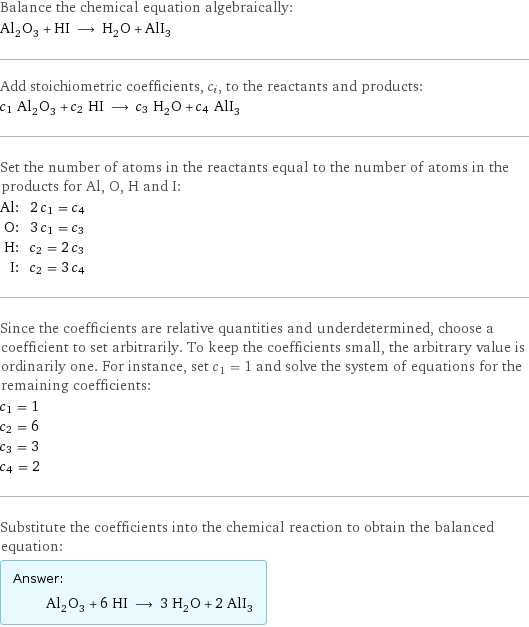
Balance the chemical equation algebraically: Al_2O_3 + HI ⟶ H_2O + AlI_3 Add stoichiometric coefficients, c_i, to the reactants and products: c_1 Al_2O_3 + c_2 HI ⟶ c_3 H_2O + c_4 AlI_3 Set the number of atoms in the reactants equal to the number of atoms in the products for Al, O, H and I: Al: | 2 c_1 = c_4 O: | 3 c_1 = c_3 H: | c_2 = 2 c_3 I: | c_2 = 3 c_4 Since the coefficients are relative quantities and underdetermined, choose a coefficient to set arbitrarily. To keep the coefficients small, the arbitrary value is ordinarily one. For instance, set c_1 = 1 and solve the system of equations for the remaining coefficients: c_1 = 1 c_2 = 6 c_3 = 3 c_4 = 2 Substitute the coefficients into the chemical reaction to obtain the balanced equation: Answer: | | Al_2O_3 + 6 HI ⟶ 3 H_2O + 2 AlI_3
Structures

+ ⟶ +
Names

aluminum oxide + hydrogen iodide ⟶ water + aluminum iodide
Reaction thermodynamics
Enthalpy
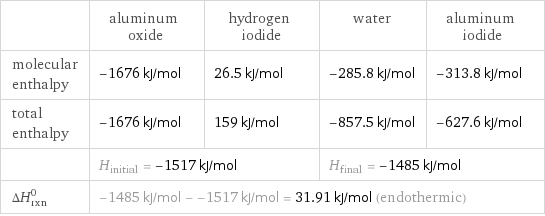
| aluminum oxide | hydrogen iodide | water | aluminum iodide molecular enthalpy | -1676 kJ/mol | 26.5 kJ/mol | -285.8 kJ/mol | -313.8 kJ/mol total enthalpy | -1676 kJ/mol | 159 kJ/mol | -857.5 kJ/mol | -627.6 kJ/mol | H_initial = -1517 kJ/mol | | H_final = -1485 kJ/mol | ΔH_rxn^0 | -1485 kJ/mol - -1517 kJ/mol = 31.91 kJ/mol (endothermic) | | |
Gibbs free energy
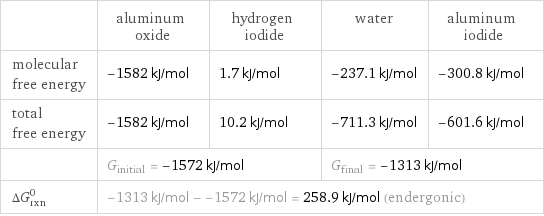
| aluminum oxide | hydrogen iodide | water | aluminum iodide molecular free energy | -1582 kJ/mol | 1.7 kJ/mol | -237.1 kJ/mol | -300.8 kJ/mol total free energy | -1582 kJ/mol | 10.2 kJ/mol | -711.3 kJ/mol | -601.6 kJ/mol | G_initial = -1572 kJ/mol | | G_final = -1313 kJ/mol | ΔG_rxn^0 | -1313 kJ/mol - -1572 kJ/mol = 258.9 kJ/mol (endergonic) | | |
Equilibrium constant
![Construct the equilibrium constant, K, expression for: Al_2O_3 + HI ⟶ H_2O + AlI_3 Plan: • Balance the chemical equation. • Determine the stoichiometric numbers. • Assemble the activity expression for each chemical species. • Use the activity expressions to build the equilibrium constant expression. Write the balanced chemical equation: Al_2O_3 + 6 HI ⟶ 3 H_2O + 2 AlI_3 Assign stoichiometric numbers, ν_i, using the stoichiometric coefficients, c_i, from the balanced chemical equation in the following manner: ν_i = -c_i for reactants and ν_i = c_i for products: chemical species | c_i | ν_i Al_2O_3 | 1 | -1 HI | 6 | -6 H_2O | 3 | 3 AlI_3 | 2 | 2 Assemble the activity expressions accounting for the state of matter and ν_i: chemical species | c_i | ν_i | activity expression Al_2O_3 | 1 | -1 | ([Al2O3])^(-1) HI | 6 | -6 | ([HI])^(-6) H_2O | 3 | 3 | ([H2O])^3 AlI_3 | 2 | 2 | ([AlI3])^2 The equilibrium constant symbol in the concentration basis is: K_c Mulitply the activity expressions to arrive at the K_c expression: Answer: | | K_c = ([Al2O3])^(-1) ([HI])^(-6) ([H2O])^3 ([AlI3])^2 = (([H2O])^3 ([AlI3])^2)/([Al2O3] ([HI])^6)](../image_source/e0553bd8bedd804d497a598700094c03.png)
Construct the equilibrium constant, K, expression for: Al_2O_3 + HI ⟶ H_2O + AlI_3 Plan: • Balance the chemical equation. • Determine the stoichiometric numbers. • Assemble the activity expression for each chemical species. • Use the activity expressions to build the equilibrium constant expression. Write the balanced chemical equation: Al_2O_3 + 6 HI ⟶ 3 H_2O + 2 AlI_3 Assign stoichiometric numbers, ν_i, using the stoichiometric coefficients, c_i, from the balanced chemical equation in the following manner: ν_i = -c_i for reactants and ν_i = c_i for products: chemical species | c_i | ν_i Al_2O_3 | 1 | -1 HI | 6 | -6 H_2O | 3 | 3 AlI_3 | 2 | 2 Assemble the activity expressions accounting for the state of matter and ν_i: chemical species | c_i | ν_i | activity expression Al_2O_3 | 1 | -1 | ([Al2O3])^(-1) HI | 6 | -6 | ([HI])^(-6) H_2O | 3 | 3 | ([H2O])^3 AlI_3 | 2 | 2 | ([AlI3])^2 The equilibrium constant symbol in the concentration basis is: K_c Mulitply the activity expressions to arrive at the K_c expression: Answer: | | K_c = ([Al2O3])^(-1) ([HI])^(-6) ([H2O])^3 ([AlI3])^2 = (([H2O])^3 ([AlI3])^2)/([Al2O3] ([HI])^6)
Rate of reaction
![Construct the rate of reaction expression for: Al_2O_3 + HI ⟶ H_2O + AlI_3 Plan: • Balance the chemical equation. • Determine the stoichiometric numbers. • Assemble the rate term for each chemical species. • Write the rate of reaction expression. Write the balanced chemical equation: Al_2O_3 + 6 HI ⟶ 3 H_2O + 2 AlI_3 Assign stoichiometric numbers, ν_i, using the stoichiometric coefficients, c_i, from the balanced chemical equation in the following manner: ν_i = -c_i for reactants and ν_i = c_i for products: chemical species | c_i | ν_i Al_2O_3 | 1 | -1 HI | 6 | -6 H_2O | 3 | 3 AlI_3 | 2 | 2 The rate term for each chemical species, B_i, is 1/ν_i(Δ[B_i])/(Δt) where [B_i] is the amount concentration and t is time: chemical species | c_i | ν_i | rate term Al_2O_3 | 1 | -1 | -(Δ[Al2O3])/(Δt) HI | 6 | -6 | -1/6 (Δ[HI])/(Δt) H_2O | 3 | 3 | 1/3 (Δ[H2O])/(Δt) AlI_3 | 2 | 2 | 1/2 (Δ[AlI3])/(Δt) (for infinitesimal rate of change, replace Δ with d) Set the rate terms equal to each other to arrive at the rate expression: Answer: | | rate = -(Δ[Al2O3])/(Δt) = -1/6 (Δ[HI])/(Δt) = 1/3 (Δ[H2O])/(Δt) = 1/2 (Δ[AlI3])/(Δt) (assuming constant volume and no accumulation of intermediates or side products)](../image_source/3d6658f4b962d033fbc5b8951d2fe6ba.png)
Construct the rate of reaction expression for: Al_2O_3 + HI ⟶ H_2O + AlI_3 Plan: • Balance the chemical equation. • Determine the stoichiometric numbers. • Assemble the rate term for each chemical species. • Write the rate of reaction expression. Write the balanced chemical equation: Al_2O_3 + 6 HI ⟶ 3 H_2O + 2 AlI_3 Assign stoichiometric numbers, ν_i, using the stoichiometric coefficients, c_i, from the balanced chemical equation in the following manner: ν_i = -c_i for reactants and ν_i = c_i for products: chemical species | c_i | ν_i Al_2O_3 | 1 | -1 HI | 6 | -6 H_2O | 3 | 3 AlI_3 | 2 | 2 The rate term for each chemical species, B_i, is 1/ν_i(Δ[B_i])/(Δt) where [B_i] is the amount concentration and t is time: chemical species | c_i | ν_i | rate term Al_2O_3 | 1 | -1 | -(Δ[Al2O3])/(Δt) HI | 6 | -6 | -1/6 (Δ[HI])/(Δt) H_2O | 3 | 3 | 1/3 (Δ[H2O])/(Δt) AlI_3 | 2 | 2 | 1/2 (Δ[AlI3])/(Δt) (for infinitesimal rate of change, replace Δ with d) Set the rate terms equal to each other to arrive at the rate expression: Answer: | | rate = -(Δ[Al2O3])/(Δt) = -1/6 (Δ[HI])/(Δt) = 1/3 (Δ[H2O])/(Δt) = 1/2 (Δ[AlI3])/(Δt) (assuming constant volume and no accumulation of intermediates or side products)
Chemical names and formulas
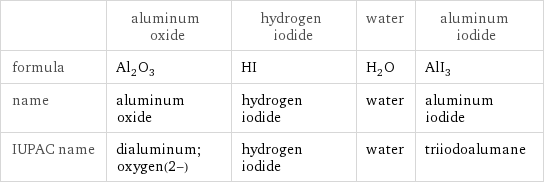
| aluminum oxide | hydrogen iodide | water | aluminum iodide formula | Al_2O_3 | HI | H_2O | AlI_3 name | aluminum oxide | hydrogen iodide | water | aluminum iodide IUPAC name | dialuminum;oxygen(2-) | hydrogen iodide | water | triiodoalumane
Substance properties
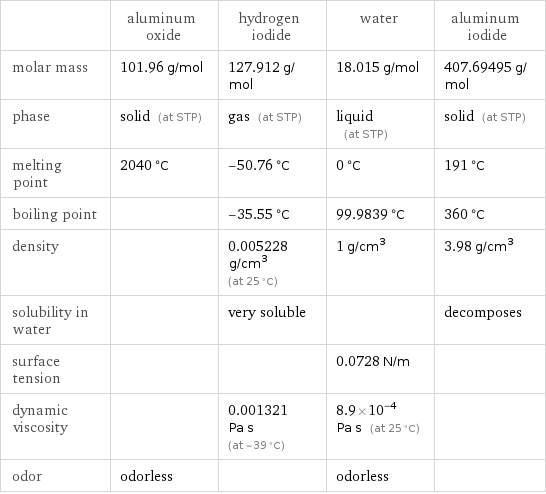
| aluminum oxide | hydrogen iodide | water | aluminum iodide molar mass | 101.96 g/mol | 127.912 g/mol | 18.015 g/mol | 407.69495 g/mol phase | solid (at STP) | gas (at STP) | liquid (at STP) | solid (at STP) melting point | 2040 °C | -50.76 °C | 0 °C | 191 °C boiling point | | -35.55 °C | 99.9839 °C | 360 °C density | | 0.005228 g/cm^3 (at 25 °C) | 1 g/cm^3 | 3.98 g/cm^3 solubility in water | | very soluble | | decomposes surface tension | | | 0.0728 N/m | dynamic viscosity | | 0.001321 Pa s (at -39 °C) | 8.9×10^-4 Pa s (at 25 °C) | odor | odorless | | odorless |
Units
